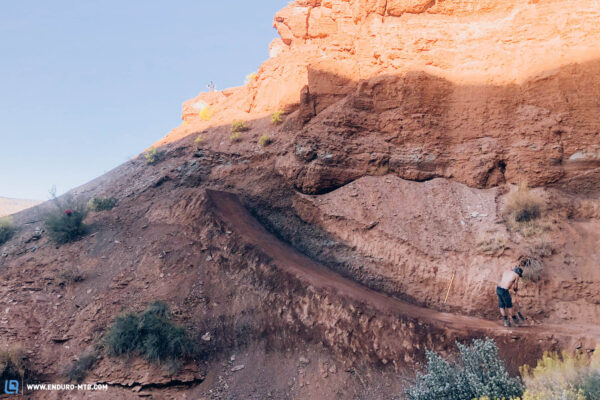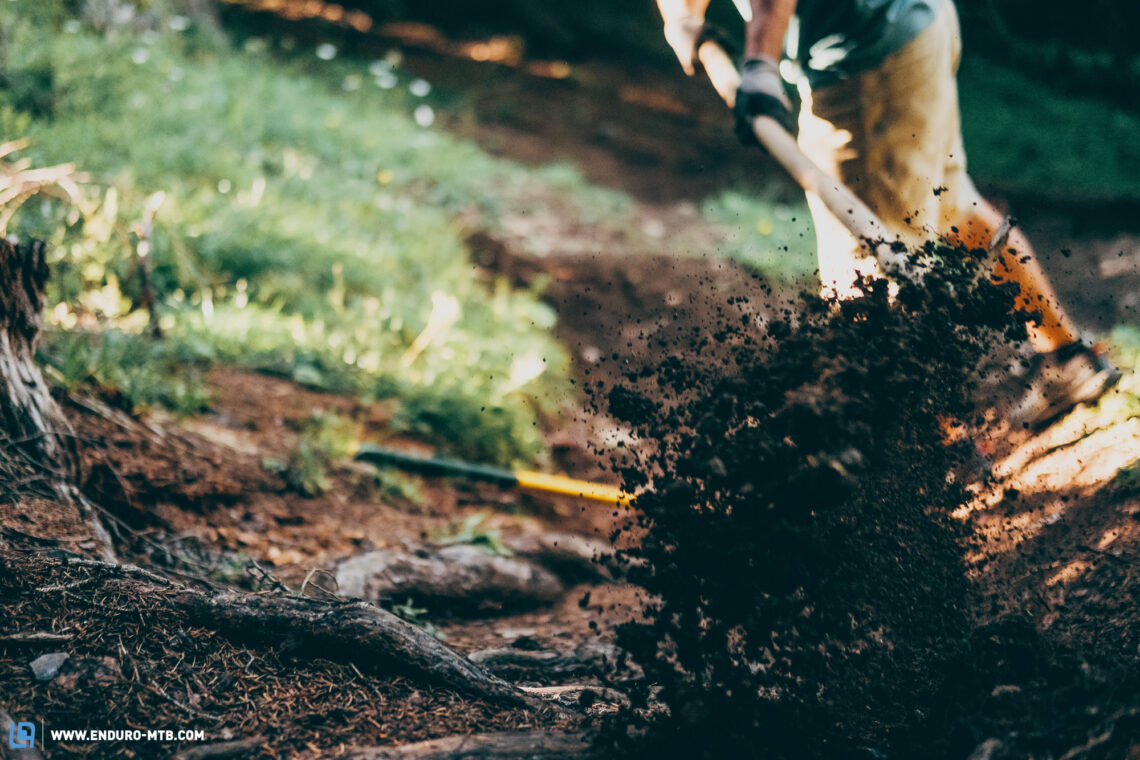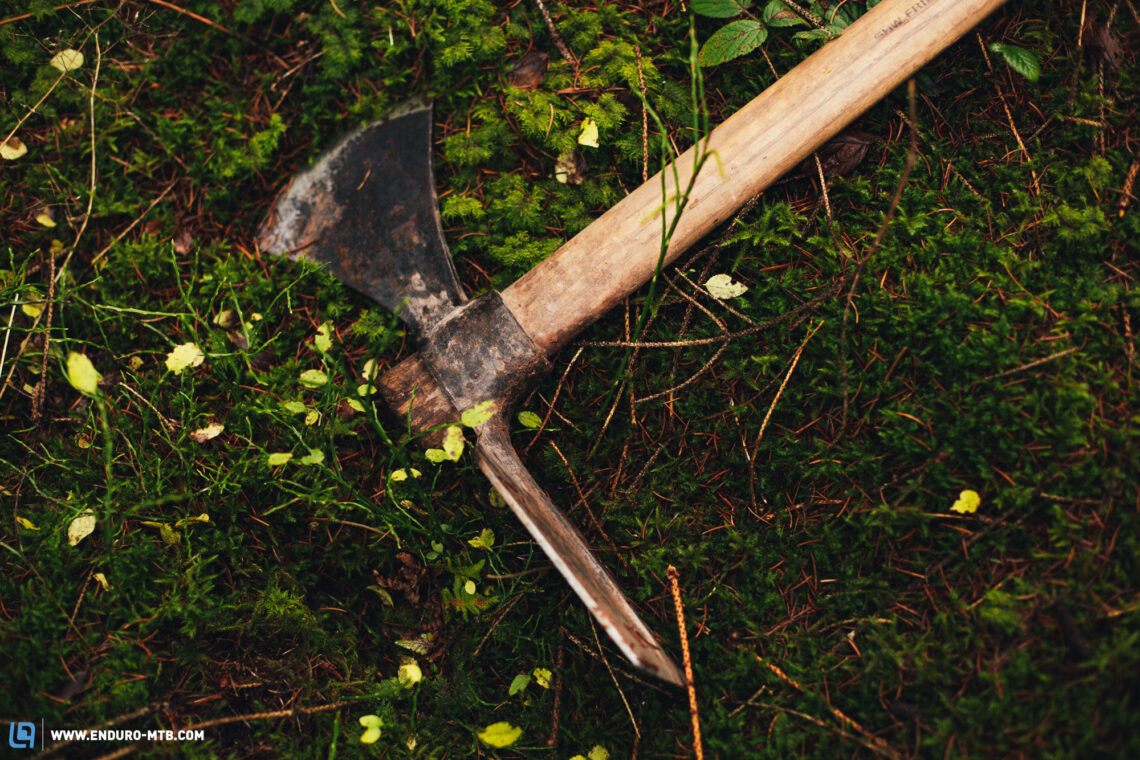Who built your favourite trail? You don’t know? That’s the case more often than not. Still, every amazing line was planned and built by someone. Why do so many of these quiet yet industrious heroes with shovels fail to get the recognition they deserve? And would they even want all that attention?
We ride them and usually don’t pay a dime to do so, yet we often don’t know to whom we owe the privilege: who are the creators of the brilliant trails we so love to ride? Who are the crew that created this work of art? No one seems to know where our favourite trails come from. There’s no sign at the trailhead, no other riders anywhere nearby, and you don’t see anything other than uncharted terrain on Strava at your current location. When we visit bike parks and official trail centres our expectations are extremely high, where as paying riders, we demand high-quality trails. They’ve got fancy names like A-Line, Triple 8, or Rollercoaster. However, we typically still don’t know who built them – like a hit song whose writer remains unknown. However, no trails simply appear by magic. Whether it’s a world-famous bike park or a secret trail in your local woods, it takes creativity, imagination, dirty hands, and a lot of sweat to turn a piece of land into something that gets us riders excited and puts big grins on our faces. So, who are the shovel wielding heroes of our sport that move in the shadows as they build these amazing trails. And do they even want to get more attention?



The trail builders out there deserve a lot more respect than they currently get. We want to find out why they’re so passionate about doing such hard work while getting such little recognition. We rounded up three high-profile representatives of this mysterious species: one on whose trails you’ll probably ride or have ridden on your once-in-a-lifetime bike trip to Whistler; one whose work features every year as the battle grounds for the world’s best gravity riders as they take each other on in front of huge crowds; and one who avoids the limelight, creating his works of art in secret. We found out about trails builders’ favourite tools, their opinion on Strava, and met one of the diggers behind Brett Rheeder’s 2022 Rampage win. By the way, do you know about the golden rule?

Unsung heroes, but why?
Trail builders hardly ever get any of the recognition that riders get when they post shots of themselves flying over jumps or shredding perfectly shaped berms. We see photos and videos of bikes, tricks, and flying dirt, but we hardly ever see the shovels that moved, shaped, and compacted the dirt into what it is and then maintain it, unfortunately. Why is that? Why are many of the creators of our favourite trails unknown figures that work in the background instead of being seen next to the trails?
The reasons for this range from the selfless idealism of some diggers to games of hide and seek with the local self-proclaimed authorities and the never ending debate about the legality or illegality of the trails they built.

It’s very important to us that you don’t give away the exact location. We lovingly refer to it as Loam Valley. – Chris, somewhere in the Black Forest
In the case of Chris and his crew, it’s the latter that applies. Together with his loyal buddy Valle and a select crew, he dedicates his free time to tending a very special corner of the Black Forest, the location of which we won’t reveal. The boys and girls have good reasons for being so secretive, and it’s got little to do with egocentrism. On the contrary, shredding with like minded riders is a big motivator of the work that they do after hours. That’s not the problem.
But let’s start from the beginning: his trail building passion grew out of the simple fact that he wasn’t satisfied by the trails that his local spots could offer. Meanwhile, trail building has become just as much of a hobby for Chris and his crew as riding their bikes. A new trail starts by scouting a location on foot, keeping an eye out for suitable terrain and interesting features like rocks, though without coming too close to deer stands. Then the crew begins with the hard physical labour of sawing, raking, and digging with a planting hoe. What is that, you ask? According to Chris, it’s a game changer in trail building!



Chris prefers steep and loamy lines that can get quite rough. Due to the steep and tight terrain of his territory, there’s no room for fast lines with big jumps. Instead, his signature style in the densely wooded Loam Valley are steep, technical lines that closely link up natural features and the occasional crux that jumps up on you mid-section. “We build trails for advanced riders,” Chris grins. Jerry traps included.
With the 2 metre rule, the region of Baden Württemberg in Germany makes it difficult to build and ride trails legally. That’s one of the reasons the boys and girls keep their trail building sessions under wraps. However, the main reason for flying under the radar isn’t due to the resistance from the local authorities. “They’re not ill disposed towards us” the Black Forest trail builders tell us. Rather, they’ve got to protect their trails from other riders to keep them in shape over the long term.
Some riders behave like pigs at the trough. Fu** Strava! – Chris
The local bike scene is booming and riders love making use of the trails built by the Loam Valley crew – more so, in fact, than they would like. “Unfortunately, most riders are all about consumption,” Chris says. In place of appreciation and the appropriate trail etiquette, he often experiences nothing more than greed when he’s out on the trails: short cuts, alterations done to the trail, and careless braking into a turn frustrate him a lot more than the legal hurdles. The Black Forest diggers would like to see more riders that use the trails also get their hands dirty and grab some shovels when it’s time to repair a feature on the trail or do maintenance. As long as riders don’t show this kind of appreciation and the legal situation surrounding trails in Baden-Württemberg doesn’t change, Chris sees no alternative to keeping his trails secret. The golden rule is: “ride, enjoy, and keep your mouth shut.“

From the underground – For the underground?
Trail builders in legally contentious spots facing regulatory hurdles like Chris in the south of Germany have a hard time getting the recognition they deserve. It’s a different story in world-renowned spots like Whistler where you can’t ignore the sound of freehubs and clicking gears as riders make their way to the closest ski lift, and mountain biking is rated highly amongst the locals. That’s the building territory of New Zealander Matt Robinson who doesn’t have to worry about keeping his work to himself in the Canadian Mountain Bike Mecca.
When he gets to work building trails for Whistler Mountain Bike Park, his most important tools aren’t things like a planting hoe and shovel, but an excavator and chainsaw. There’s a crew that comes on foot with rakes, pickaxes, and buckets for the more detailed work once he’s been through. They remove rocks and sticks, they dig up stumps, and dig countless drainage holes and channels to create a stable foundation that will withstand thousands of knobby tires rolling over it for as long as possible. Then all that’s left to do is add a sign to the trailhead of the finished trail! How about A-Line, for example?
In the region surrounding Whistler, trail builders like myself certainly get respected. – Matt Robinson
That’s not the reality that Chris experiences in the Loam Valley, where some riders don’t seem to care who put in all the effort to create the favourite trail – as long as it’s there. Fortunately, however, it’s not everywhere that diggers get forced to live in the shadows due to regulations and rude trail riders. The core of the mountain bike scene has always given trail builders the respect they deserve. It’s no wonder since we’ve always had to get to work ourselves when we wanted to ride something new. Not more than a decade ago, riders of the then burgeoning scene had a hard time finding any trails at all. These days it gets taken for granted that we’ll find a good mountain bike trail somewhere in our local woods. And thanks to Trailforks, Strava & co. you don’t have to go looking for very long either. But we say, honour those to whom honour is due! Those who have put in the effort to build their own lines and jumps will always respect the work of other trail builders.


Recently, diggers have come more into focus thanks to certain trends and pioneers: in his video for the 2021 X Games, Brage Vestavik featured his hard-working crew as they shaped and built trails in the Norwegian forest. #DeepInTheSesh is a term used to refer to building and riding as an emotional whole. At the upper end of the size spectrum, you’ve got the makers of the Fest Series who move tons of dirt to shape house-sized jumps that eventually generate the kind of airtime that seems to defy the laws of physics. Building is a firm part of the process here, too. And at the freeride highlight that is the Red Bull Rampage it’s not just the best riders that get prizes, but since 2021 also the best diggers for having carved the most creative and spectacular lines out of the mountains in the desert of Utah. Like Phil McLean – another Kiwi – who got the Digger Award together with Austin Davignon after digging for Brett Rheeder who took home the gold medal.
„There’s always been something that drove me to build my own stuff, it’s just so satisfying riding something you’ve spent so much time creating and perfecting. We had a lack of good jumps to progress to the level we wanted to reach, so we had to build them ourselves!“ – Phil McLean
„I’ve built everything from rough trails in the woods, to all-in bike park lines and helicopter access trails in the backcountry. What motivates me to build trails is the satisfaction of knowing this trail will be around for a long time, and the joy it’s going to bring people.“ – Matt Robinson
That sounds a lot like Chris in the Black Forest Loam Valley?! Indeed, Phil says: “In my free time, I usually build dirt jump trails for myself and for whoever feels like it.” Otherwise, he builds trails at the Rampage, Joyride and in Whistler. Matt also likes to dig his own trails when he isn’t busy on famous trails in Whistler, and he enjoys the building process regardless of the weather. So, it seems that all diggers are driven by idealism and passion to do what they do. The stages and recognition of big events isn’t the most important motivator behind the sweat and blisters that trail builders must endure, but simply a by-product thereof. “I like to build trails and features that encourage progression and push people into advanced levels of the sport. It would be great to see more people focus on taking their jump skills beyond beginner/intermediate level so the sport can grow in a more exciting way,” says Phil is what motivates him.

The trail building tools of the Kiwis are very similar to those used in the Black Forest. Phil’s armoury is made up of a flat spade, rake, and pickaxe. To him, the perfect trail consists of a mixture of demanding tech, steep gradients, big jumps, and berms. Lines can be adapted to suit many different types of terrain. What builders often overlook, according to Phil, are details like the rider’s speed, braking points, drainage, field of vision … it all matters. His advice for all those who’d like to give it a try themselves: have a few tries and don’t expect it to be perfect that first time around. Too steep, too flat, too fast, too slow. “Keep on trying until it all works.”
Ok, got it. And when you’ve perfected the trail it’s time to upload it to the various online platforms? Well, no… then you’ve got to make sure it stays maintained. Important rules to keep in mind: don’t shralp through corners and don’t damage the jumps by rolling over them. It’s enough to pull up just a little bit! Phil goes so far as to lock up his personal dirt jumps to keep them from getting damaged or altered. Good sessions with his crew are all the recognition he needs. Matt adds that you shouldn’t ride new trails when it’s wet to avoid damaging them before they get ridden in. And hidden lines should remain just that, instead getting uploaded to the internet for the world to find. When it comes to bike park trails or public trail centres, there’s one last rule that Phil and Matt agree on: “Have fun!”


Strengthen the digging culture
We’ll always have a soft spot for our own perfect secret tail. This bubble where you don’t need anything other than a few tools and some like minded friends to experience unforgettable moments. But besides all this beautiful inner-circle romance, the secret creators of our trails deserve to get more recognition for the work they put in to make our sport what it is. Every now and then, we should stop and ask ourselves to whom we owe the smiles that this or that nameless dream line puts on our faces. The more recognition we give to the makers of good trails, the more others might be motivated to try their hand at digging and getting themselves a planting hoe. And if it’s good, you’re welcome to put your name on it and get the respect you deserve. It allows the scene to grow and even creates new career paths and opportunities, like with Velosolutions who build pumptracks and trails for towns, villages, and schools all around the world. Of course, the legal regulations play an important role. Ultimately, however, you won’t achieve anything by doing nothing. In other words: no dig, no ride!
Whether it’s done after hours and hidden somewhere in the depths of the Black Forest, or for Brett Rheeder himself at the Red Bull Rampage, which gets live streamed: trail builders shape the sport. What diggers want more than a big crowd of cheering fans is just respect and appreciation for their work. The cherry on top would be if more riders got motivated to pick up a shovel and get digging themselves. We say hell yeah to both. No dig, no ride!
Did you enjoy this article? If so, we would be stoked if you decide to support us with a monthly contribution. By becoming a supporter of ENDURO, you will help secure a sustainable future for high-quality mountain bike journalism. Click here to learn more.
Words: Moritz Geisreiter Photos: Peter Walker, Christoph Bayer, Cole Nelson









